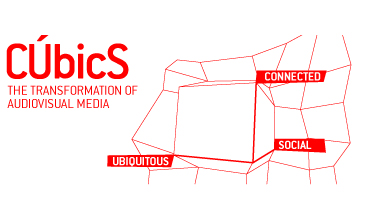
International experts explore the new dimensions of audiovisual media at ‘CúbicS’
The seminar, run by the Centre for Audiovisual Research (Centre de Recerca Audiovisual, CREA) of the Catalan Broadcasting Corporation (CCMA), analysed the transformation of the media
‘Connected’, ‘Ubiquitous’ and ‘Social’ were the three concepts analysed this morning at the seminar ‘CÚbicS: The Transformation of Audiovisual Media’ organised by the Catalan Broadcasting Corporation (Corporació Catalana de Mitjans Audiovisuals, CCMA) through its Centre for Audiovisual Research (Centre de Recerca Audiovisual, CREA) run from Activa Multimèdia.
Enric Marín, President of the CCMA’s Governing Council, opened the proceedings while recalling the importance of pledging commitment to knowledge – the real key to ensure that the media will not become obsolete. For this reason, it is essential, as he pointed out, “that public companies, together with private companies, universities and research centres, develop knowledge-based strategies”. Marín remarked that “any debates on the need and the importance of public media can only be won by applying those initiatives that seek innovation and knowledge to productive processes”. For the last five years, the CCMA has taken part in nearly 40 research projects in collaboration with leading research companies and centres.
Joan Rosés, Head of CREA and of Activa Multimèdia, underlined the need to effect a transformation of the media and defined the new dimensions they are adopting – they are increasingly connected, they distribute themselves across varied platforms and they are more and more integrated into social networks. In addition, Mr Rosés reviewed the devices of connected television.
During his intervention, Brian David Johnson, Director of Future Casting and Experience Research at Intel Corporation, wondered what the future of television would be like. Johnson thinks that people will continue to watch television, but “the definition of ‘watching television’ has widened its meaning. By ‘television’ we no longer understand a TV set or indeed some TV content – ‘television’ is now a ubiquitous, personal and social information experience”. So people, for instance, shall still gather to watch television as a group, but the content will probably no longer be simply live, but à la carte content. Johnson remarked that “consumption models and technology change rapidly, but the business models that sustain them are slower. We need time to assimilate changes”.
Peter Boland, President of Universal McCann Spain, analysed the role of advertising in this future scenario. He pointed out that, despite the fact that audiovisual consumption has shot up, advertising agencies and brands have not changed their mentality yet. Thus, they still seek to persuade consumers, when in fact they should look for audiovisual formulae to establish links among them. They should be “generating experiences and making impacts; they should foster participation and entertain. The brand may be intrusive, but if the campaign is amusing, indeed, emotional, there is no problem. We need to use technology to play and create new consumer experiences”. Boland remarked that the aim of agencies and brands should be this: “to establish a dialogue with consumers, while offering them information that may be of relevance, so that the brand may last with time”.
The promoter of multiplatform distribution strategy at the BBC, Simon Nelson, examined the way communication media are adapting themselves in order to be present on all screens. The public browses more and more on the Internet looking for what they want to see, so that if a programme is not online, it is invisible. At the BBC, production teams have transformed into multiplatform teams capable of managing their own portals – a change that has enabled an optimisation of resources. With all, Nelson remarked that viewings on iPlayer involved less than 1% of BBC consumption through television. With initiatives such as the iPlayer “the great challenge was simplicity, how to open the file and organise the information in a simple and easy way, because what people want is just to click and view. Applications should be simple and non-intrusive”. In this sense, it is essential to provide the system with solid foundations that are easy to update with time.
The session was concluded by Geni de Vilar, Deputy Head at CREA, who gave details on how the communication media are positioning themselves in order to be on the social networks. The first step involved placing the brands, but later it has been seen that they allow for a wide range of possibilities that must be made good use of – comment dropping, content sharing, recommending, effecting collective viewings through virtual lounges... They have even been the source of inspiration for content creation. At the moment, the presence on Facebook is inevitable, and practically all stations have their own channels on YouTube and use of Twitter is on the increase.
Marie-José Montpetit, Social TV researcher at the Massachusetts Institute of Technology (MIT), was not able to attend the seminar in the end, as the snow storms in the north of Europe made it impossible for her connecting flight to Barcelona to take off.
For further information on the seminar, you may check the recently-launched website of CREA, http://crea.ccma.cat.
The seminar, run by the Centre for Audiovisual Research (Centre de Recerca Audiovisual, CREA) of the Catalan Broadcasting Corporation (CCMA), analysed the transformation of the media
‘Connected’, ‘Ubiquitous’ and ‘Social’ were the three concepts analysed this morning at the seminar ‘CÚbicS: The Transformation of Audiovisual Media’ organised by the Catalan Broadcasting Corporation (Corporació Catalana de Mitjans Audiovisuals, CCMA) through its Centre for Audiovisual Research (Centre de Recerca Audiovisual, CREA) run from Activa Multimèdia.
Enric Marín, President of the CCMA’s Governing Council, opened the proceedings while recalling the importance of pledging commitment to knowledge – the real key to ensure that the media will not become obsolete. For this reason, it is essential, as he pointed out, “that public companies, together with private companies, universities and research centres, develop knowledge-based strategies”. Marín remarked that “any debates on the need and the importance of public media can only be won by applying those initiatives that seek innovation and knowledge to productive processes”. For the last five years, the CCMA has taken part in nearly 40 research projects in collaboration with leading research companies and centres.
Joan Rosés, Head of CREA and of Activa Multimèdia, underlined the need to effect a transformation of the media and defined the new dimensions they are adopting – they are increasingly connected, they distribute themselves across varied platforms and they are more and more integrated into social networks. In addition, Mr Rosés reviewed the devices of connected television.
During his intervention, Brian David Johnson, Director of Future Casting and Experience Research at Intel Corporation, wondered what the future of television would be like. Johnson thinks that people will continue to watch television, but “the definition of ‘watching television’ has widened its meaning. By ‘television’ we no longer understand a TV set or indeed some TV content – ‘television’ is now a ubiquitous, personal and social information experience”. So people, for instance, shall still gather to watch television as a group, but the content will probably no longer be simply live, but à la carte content. Johnson remarked that “consumption models and technology change rapidly, but the business models that sustain them are slower. We need time to assimilate changes”.
Peter Boland, President of Universal McCann Spain, analysed the role of advertising in this future scenario. He pointed out that, despite the fact that audiovisual consumption has shot up, advertising agencies and brands have not changed their mentality yet. Thus, they still seek to persuade consumers, when in fact they should look for audiovisual formulae to establish links among them. They should be “generating experiences and making impacts; they should foster participation and entertain. The brand may be intrusive, but if the campaign is amusing, indeed, emotional, there is no problem. We need to use technology to play and create new consumer experiences”. Boland remarked that the aim of agencies and brands should be this: “to establish a dialogue with consumers, while offering them information that may be of relevance, so that the brand may last with time”.
The promoter of multiplatform distribution strategy at the BBC, Simon Nelson, examined the way communication media are adapting themselves in order to be present on all screens. The public browses more and more on the Internet looking for what they want to see, so that if a programme is not online, it is invisible. At the BBC, production teams have transformed into multiplatform teams capable of managing their own portals – a change that has enabled an optimisation of resources. With all, Nelson remarked that viewings on iPlayer involved less than 1% of BBC consumption through television. With initiatives such as the iPlayer “the great challenge was simplicity, how to open the file and organise the information in a simple and easy way, because what people want is just to click and view. Applications should be simple and non-intrusive”. In this sense, it is essential to provide the system with solid foundations that are easy to update with time.
The session was concluded by Geni de Vilar, Deputy Head at CREA, who gave details on how the communication media are positioning themselves in order to be on the social networks. The first step involved placing the brands, but later it has been seen that they allow for a wide range of possibilities that must be made good use of – comment dropping, content sharing, recommending, effecting collective viewings through virtual lounges... They have even been the source of inspiration for content creation. At the moment, the presence on Facebook is inevitable, and practically all stations have their own channels on YouTube and use of Twitter is on the increase.
Marie-José Montpetit, Social TV researcher at the Massachusetts Institute of Technology (MIT), was not able to attend the seminar in the end, as the snow storms in the north of Europe made it impossible for her connecting flight to Barcelona to take off.
For further information on the seminar, you may check the recently-launched website of CREA, http://crea.ccma.cat.


